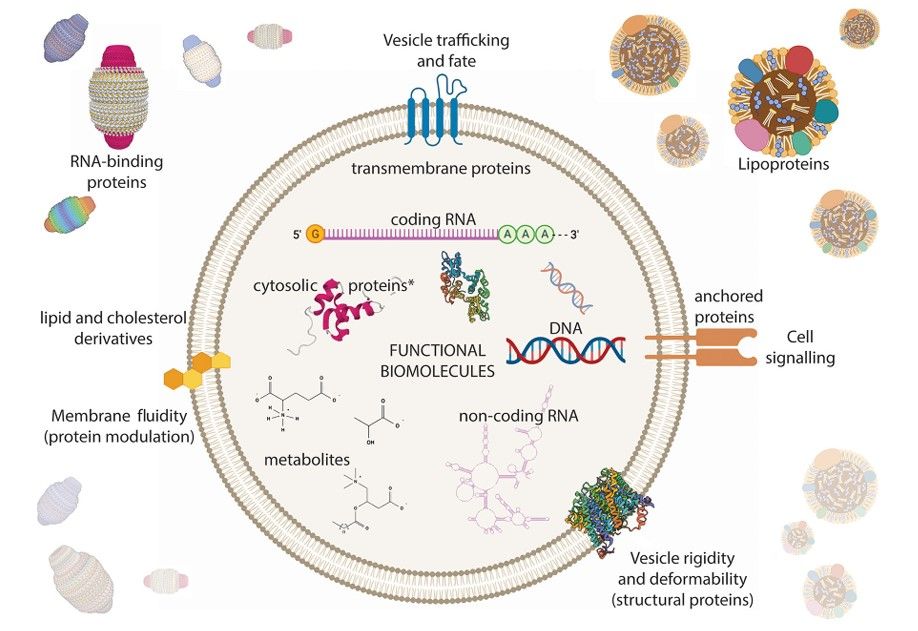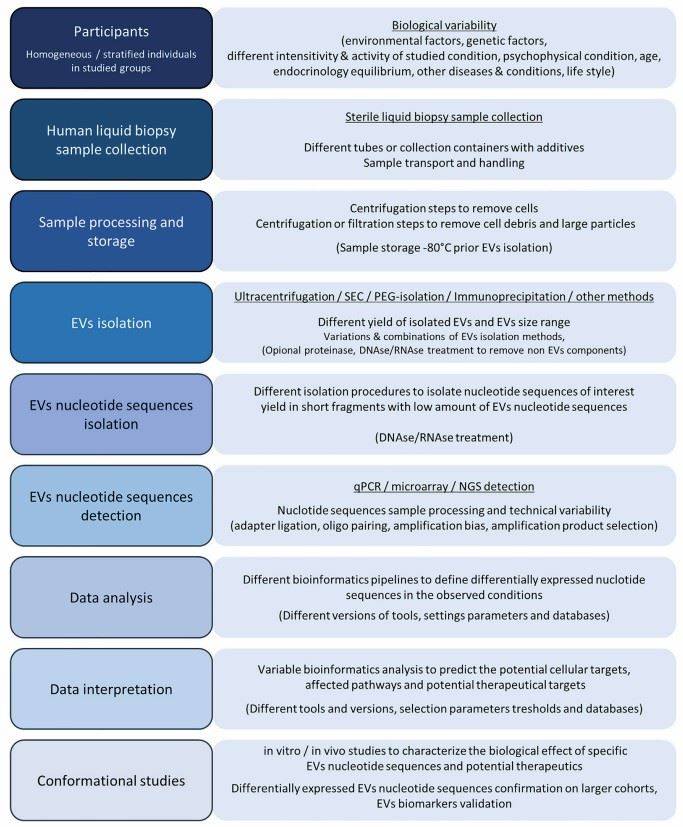Extracellular Vesicle RNA Isolation and Profiling Service
Overview Services Features FAQs
The profiling of RNA for EVs can reveal the molecular mechanisms of cellular pathologies in which EVs are involved, facilitating the discovery of EVs-based disease biomarkers and the development of potential therapeutic strategies. Creative Biolabs has built a comprehensive RNA isolation and profiling technology platform for EVs, assisting customers in revealing the EVs-based RNA molecular cargo and its potential functions.
EV RNA Overview
RNA isolation and analysis of EVs is a process designed to capture and isolate significant RNA molecules from EVs and a powerful tool for interrogating the molecular components of EVs, which can provide valuable data for many biological studies. RNA profiling of EVs can be applied to identify disease-associated pathways involved in EVs, infer gene collaboration, and understand EVs-mediated molecular networks that drive cellular behavior. By analyzing the content of EVs RNA, researchers can elucidate the genome-wide impact of signaling processes involved in EVs and their unique and universal responses to physiological and pathological conditions. Furthermore, it also facilitates the development of new therapeutic strategies based on EVs and the monitoring of disease treatment progression, manipulating the cellular RNA landscape and exploiting it to play an active role in maintaining homeostasis.
 Fig.1 EV composition in the context of biological solutions.1
Fig.1 EV composition in the context of biological solutions.1
Methods of RNA Isolation and Analysis for EVs in Creative Biolabs
-
RNA in EVs can be extracted by cell precipitation, separation, and non-lipid filtration methods.
-
The cell precipitation method involves placing the cell suspension in a clean centrifuge tube, followed by precipitation of the cells with specific reagents, and filtering the filtrate after cell precipitation to obtain EVs and their RNA.
-
The separation method uses specific antibodies or specific antigens to separate the vesicles from the cells and extract RNA from the suspension.
-
The non-lipid filtration method is based on the property of the vesicles themselves to encapsulate RNA, and the suspension is filtered through a specific filter sieve to extract RNA from the vesicles.
-
RNA isolation from EVs requires breaking the membrane of EVs to determine the total RNA contents. Various enzymatic techniques are used to disrupt the surface membrane of EVs, which allows the RNA content in EVs to be distributed and collected. Once released, the RNA content can be further purified and characterized by nucleic acid isolation and analysis techniques such as PCR, RT-PCR, and RNA sequencing.
-
The resulting data can contribute to determining the functional role of EVs in cellular processes and the complex interactions that occur between endogenous molecules and exogenous messengers. In addition, it could allow researchers to understand the molecular information network that EVs deliver to cells to manipulate cellular metabolism, signaling pathways, and genetic responses.
 Fig.2 Graphical presentation of basic steps and possible variability factors in the EV processing and EV nucleotide sequence analysis.2
Fig.2 Graphical presentation of basic steps and possible variability factors in the EV processing and EV nucleotide sequence analysis.2
Features
-
Specialized Techniques: Our service employs cutting-edge methods tailored for extracting RNA from extracellular vesicles, ensuring high yield and quality.
-
Comprehensive Profiling: We provide in-depth analysis of RNA profiles within extracellular vesicles, offering insights into diverse RNA species such as microRNAs and long non-coding RNAs.
-
Customizable Solutions: Tailored protocols to meet specific research needs, accommodating various sample types and downstream applications.
-
Quality Control: Rigorous quality assessments ensure reliable data, including measures for RNA integrity and purity.
The extensive RNA in EVs provides a rich source of molecular information for understanding the specific properties and functions of EVs and their donors. Creative Biolabs provides high-quality RNA isolation and profiling services for EVs, allowing clients to advance further research into the molecular information of EVs. Please contact us to discuss your project. Please contact us to advance your research.
FAQs
Q: What types of extracellular vesicles are compatible with your RNA isolation services?
A: Our services are compatible with various types of extracellular vesicles, including exosomes and microvesicles, derived from diverse biological fluids and cell cultures.
Q: How do you ensure RNA integrity during the isolation process?
A: We employ methods that minimize RNA degradation, such as rapid processing and the use of RNase inhibitors. Additionally, we validate RNA integrity through analytical techniques.
Q: Can your services accommodate small sample volumes?
A: Yes, our protocols are optimized for small sample volumes, maintaining efficiency and yield without compromising data quality.
Q: What downstream applications are supported by your RNA profiling services?
A: Our services support a wide range of downstream applications, including qRT-PCR, RNA sequencing, and microarray analysis, tailored to your specific research objectives.
References
-
Veziroglu, Eren M., and George I. Mias. "Characterizing extracellular vesicles and their diverse RNA contents." Frontiers in Genetics 11 (2020): 700.
-
Tesovnik, Tine, et al. "Technological approaches in the analysis of extracellular vesicle nucleotide sequences." Frontiers in Bioengineering and Biotechnology 9 (2021): 787551.
-
Under Open Access license CC BY 4.0. The image was modified by revising the title.
For Research Use Only. Cannot be used by patients.
Related Services:

 Fig.1 EV composition in the context of biological solutions.1
Fig.1 EV composition in the context of biological solutions.1
 Fig.2 Graphical presentation of basic steps and possible variability factors in the EV processing and EV nucleotide sequence analysis.2
Fig.2 Graphical presentation of basic steps and possible variability factors in the EV processing and EV nucleotide sequence analysis.2









